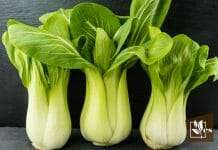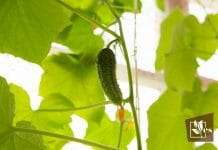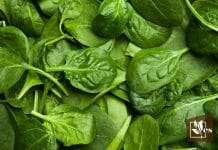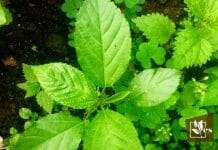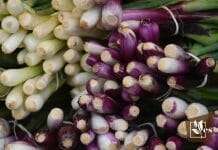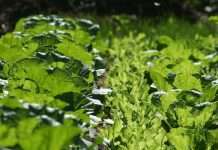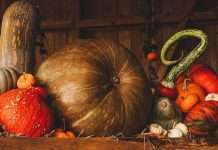- 7 Colorful Dusty Miller Companion Plants To Grow - March 11, 2024
- Giant Green Arborvitae Spacing: All There Is To Know Regarding This - March 5, 2024
- 7 Fruit Trees for Zone 9: The Perfect Fruit Garden - March 4, 2024
Thai basil vs. holy basil — what is the difference between these two basil varieties? Both are popular herbs used in cooking and medicinal applications, and both belong to the same Lamiaceae plant family.
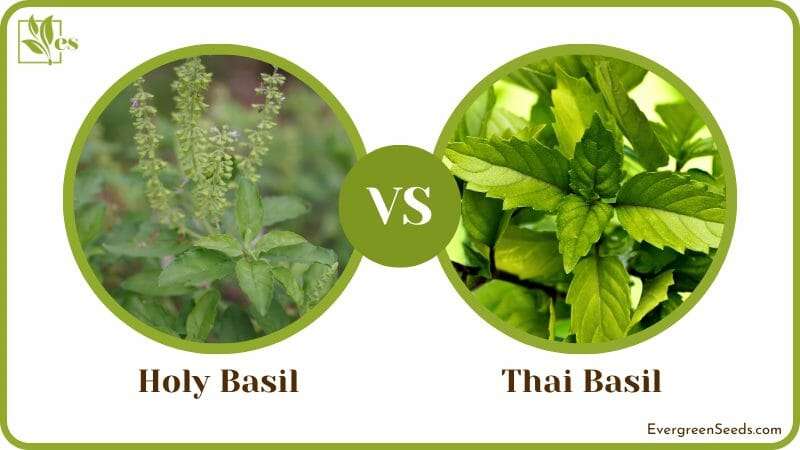
But how do they differ? This guide will discuss their similarities and differences of these Ocimum genus herbs before explaining how to grow each type at home and how to protect them from pests.
Let’s start by taking a closer look at each variety.
JUMP TO TOPIC
All about Thai basil
Thai basil is an aromatic herb native to Southeastern Asia. It is a prevalent ingredient in cooking throughout Thailand, from where its name stems.
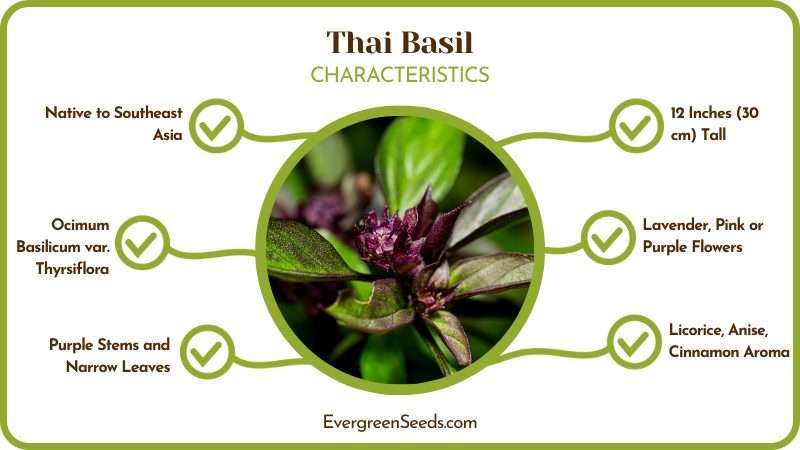
Highly fragrant and aromatic, Thai basil has distinctive licorice or anise flavor, a hint of cinnamon, and a mild spicy taste. Like all species of basil, it belongs to the same plant family as mint.
What does Thai basil look like?
In its native range, Thai basil is a tropical or subtropical plant that can grow up to 3 feet (90 cm) tall. Unlike other basil varieties, it has unique purple stems and narrow leaves with a slightly serrated edge, usually green with purple accents around the stems and veins.
If it’s allowed to bloom, Thai basil produces clusters of purple blooms that look quite similar to mint flowers and are just as aromatic as the leaves. Thai basil is often kept as a small shrub. The stems and flower buds regularly pinched back to encourage bushiness and preserve flavor.
Thai basil uses
Thai basil is a fun and versatile culinary herb that works in a wide array of dishes. It is more forgiving than other basil varieties and can withstand higher cooking temperatures without losing its texture and aroma. You can use it as either a fresh herb or cooked.
Our tip is to use it in Thai-style dishes to boost authentic flavor by adding traditional recipes such as Thai green curries, pad gra prow, or Phô.
All about Holy basil (Thai holy basil)
Also known as tulsi, holy basil is a variety of basil native to India. When used in Thai-style dishes, it is common to find it under the Thai holy basil name. It is so popular in Thailand that the name Thai holy basil stuck in general use. It can create some confusion when it comes to differentiating it from the actual Thai basil. Yet, they are two different herbs, each with its unique aroma.
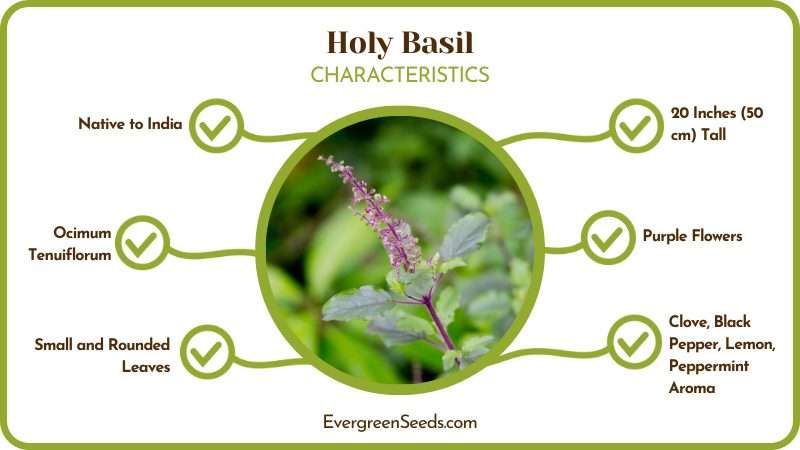
What does holy basil look like?
Holy basil is a perennial shrub that can grow anywhere between 1 and 2 feet tall (30 to 60 cm). Its leaves are small and rounded, with noticeable serrations along the edge, and are typically green. Some varieties have purple leaves, such as the Krishna Tulsi, but they are more commonly grown in India and Nepal.
Holy basil uses
Like Thai basil, the holy basil variety is very aromatic. It has a distinctive sweet taste and a clove aroma, with mild hints of black pepper, lemon, and even peppermint. You can best enjoy this delicate herb fresh and added right at the end of your cooking to preserve its flavor. You can also dry it and use it to make tea.
Holier than thou?
Why is it called holy basil? Like its Italian counterpart, tulsi has a vital role in religious practices.
It is considered the most sacred of all plants in Hinduism and used in the worship of Vishnu. It is not uncommon for Hindu households to grow holy basil in their garden center and worship it twice a day.
Tulsi is also considered the “queen of herbs” in Ayurvedic practices and is used in traditional medicine to strengthen the body’s resistance to diseases and stress.
What’s the difference between Thai basil and holy basil?
For starters, Thai basil and holy basil are two different species.
Let’s draw a quick side-by-side comparison between the two and see just how you can tell them apart:
|
Thai basil |
Holy basil (Tulsi) |
|
| Species Latin name | Ocimum basilicum var. thyrsiflora | Ocimum tenuiflorum |
| Native range | Southeast Asia | India |
| Appearance | Shrub | Shrub |
| Average size | 12 inches (30 cm) tall | 20 inches (50 cm) tall |
| Leaves | Green with purple accents, small, narrow, with a slightly serrated edge | Green, small, rounder, with a slightly serrated edge |
| Stems | Purple and smooth | Green and covered in small hairs |
| Flowers | Lavender, pink or purple | Purple |
| Taste and aroma | Licorice, anise, cinnamon | Clove, black pepper, lemon, sometimes peppermint |
Use this handy chart, and you will never have problems telling Thai basil and holy basil plants apart!
Thai basil vs holy basil in the kitchen
When it comes to cooking, these two basil varieties also have slightly different uses.
Holy basil has smaller, more delicate leaves and is used mostly as a medicinal herb. The dried leaves make an excellent tea, with a mild minty flavor and clove aroma, and numerous health benefits: it is antiviral, antioxidant, antibacterial, and also relieves stress.
You can also use fresh leaves in cooking, in recipes such as stir-fries, curries, soups, or Asian-style noodles. They are best added right at the end, as the heat and long cooking times can strip it of its flavor and texture.
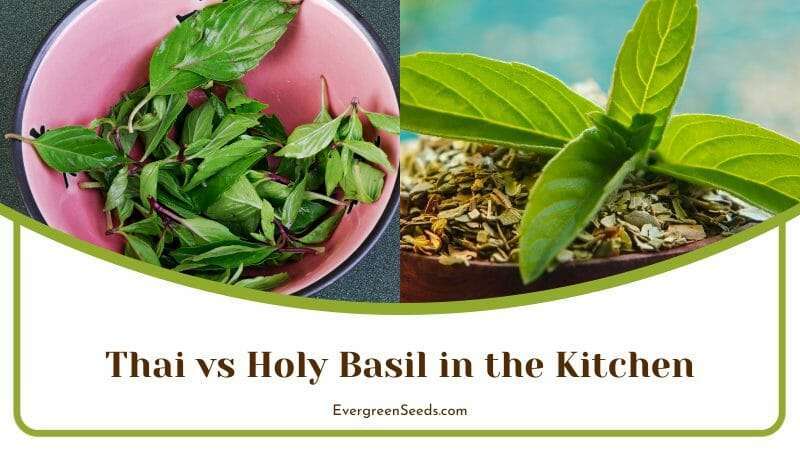
If you’re looking for a cooking herb, Thai basil is the best choice between the two. The leaves are thicker and retain their texture and aroma better when cooked. It pairs wonderfully with Thai, Vietnamese and Cambodian recipes. If you don’t mind the licorice taste, you can also use it to make pesto.
Both Thai and holy basil are best used fresh. If you can’t use all of it straight away, the best way to preserve these herbs is by putting them in a glass with water, just like cut flowers.
To store the holy basil, you need to dry it and keep it in paper bags, the same way as tea leaves. For Thai basil, wash and then dry the leaves with a paper towel, then store them in the freezer. It’s best to note that both Thai and holy basil don’t refrigerate well, so try to avoid that if possible.
Italian basil vs Asian basil varieties
The most common variety of basil used in Western cuisine is great basil (Ocimum basilicum), also known as Italian or Genovese basil. Its sweet flavor is a match made in heaven with tomatoes, but it also works wonderfully in sauces such as pesto and drinks such as lemonade.
What is the difference between Italian basil and Asian varieties, such as Thai and holy basil? The main factor is taste.
Italian basil is sweet, with a very mild peppery aroma and just a mint and anise hint. Meanwhile, Asian basil is far more aromatic, less sweet, and packing a bit more peppery heat. Thai basil has a particularly distinctive licorice aroma, while holy basil brings clove notes to the table. If you’ve never cooked with Asian basil varieties before, prepare your taste buds for a pleasantly surprising burst of flavor.
You can also tell Italian basil and Asian basil apart by looking at the leaves.
The Italian variety has green, large, round leaves that look very similar to spinach. The edges of the leaf are always smooth and slightly concave. Asian basil leaves are smaller, somewhat oblong, and can be either green, purple, or both. Their leaves also have a serrated edge which is particularly noticeable in holy basil. Also, Thai basil has distinctive purple stems, unlike the Italian or tulsi varieties.
How to grow Asian basil
Basil is one of the most exciting herbs you can use in your kitchen, and it always tastes best when fresh. It’s also easy to grow in containers, so if you have a spare spot in your kitchen, having a pot of homegrown basil is a must.
You can grow Thai basil and holy basil from cuttings, but we’ll be taking a look at growing them from seeds in this quick guide.
Here’s how.
Growing Thai basil in containers
Thai basil is a tropical plant native to Southeast Asia, which means that it thrives in a warm, sunny and humid environment.
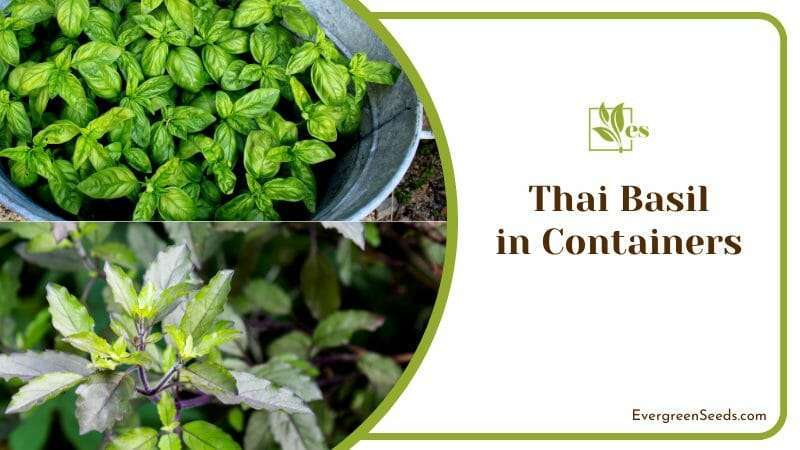
– Find the right container
To grow your own, start by picking the right container. A 6 inch (15 cm) pot with drainage holes is enough for one plant. Fill the container with potting mix and perlite or coir to improve drainage. Using a spray pump, gently mist the soil until it becomes moist, plant 2 or 3 Thai basil seeds, and cover with a thin layer of soil.
– Germination
Keep the soil moist in a room where temperatures don’t drop below 70 °F (21 °C). The seeds can take between 7 and 10 days to germinate. Once the young plants have 2 – 3 sets of leaves each, you can thin them out and keep the healthiest one.
– Let in the light
Thai basil is particularly sensitive to too little light. It needs at least 6 hours of sunlight per day to thrive. During winter, providing it with enough light can be tricky. Our recommendation is to keep it in the west, or south-facing window or use grow lights if needed.
– Watering and fertilizer
Water your Thai basil regularly, but avoid soaking the soil. The best way to check if the plant needs some watering is by touching the soil: if the top inch feels dry to the touch, it’s time to water it. If possible, try not to splash water on the leaves, as this can cause fungal problems later on. As the plants grow, apply a liquid fertilizer once a month. Organic fertilizers like liquid seaweed or fish emulsion are perfect for Thai basil.
– Harvesting Thai basil
You can harvest your Thai basil leaves when the plant is at least 6 inches (15 cm) tall. The best time to do this is just before noon when the leaves’ aromatic oils have the highest concentration. Gently cut the leaves using a pair of scissors and regularly snip off side stems to encourage more growth and a bushy shape.
If you notice that your Thai basil plant is starting to flower, it’s best to remove the buds, as they can make the leaves bitter. Luckily, the flowers are also edible and have the same licorice aroma as the leaves. They also get bonus points for their decorative looks.
Growing holy basil in containers
Holy basil or tulsi is an excellent herb for containers, and it’s easier to grow than Thai basil. It can tolerate some partial shade, so if your kitchen doesn’t get full sun, this variety is perfect for you.
– Find the right container
Start by filling a 6 inch (15 cm) container with potting mix and perlite. Ensure that the soil is moist, then place 2 or 3 holy basil seeds per pot, and sprinkle a thin layer of soil on top. Use a spray pump to mist the soil daily to keep it moist.
– Germination
The best temperature for seed germination is around 70 °F (21 °C). On average, the seeds can take anywhere between 7 and 14 days to germinate. Thin out the plants when they have at least two sets of leaves each, keeping the healthiest looking one in the pot.
– Location, watering, and fertilizer
Place your potted holy basil on a warm and sunny windowsill, where it can get around 6 hours of light each day. Check the soil before every watering, and only water the plants when the top inch feels dry to the touch. Once a month, apply an organic liquid fertilizer solution to stimulate leaf growth.
– Harvesting holy basil
You can harvest holy basil about 40 days after planting the seeds. Use a pair of scissors and cut the leaves as and when needed. Tulsi can grow almost 20 inches (50 cm) tall, so we recommend regular pruning of side stems and tips to help it keep its shape.
Like all herbs, holy basil leaves can develop a bitter taste if the plant is allowed to flower. The purple blooms do have some ornamental value, so you can keep them on if you prefer.
Otherwise, it’s best to remove them. They are perfectly edible and can be dried and turned into tea.




